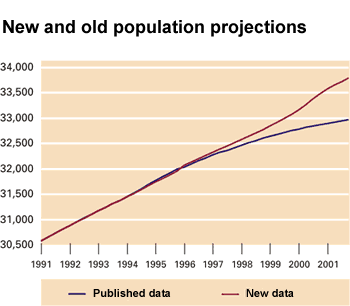INEbase / Labour market / Economically Active Population Survey / Repercussion of the EAPS-2002 methodological changes
|
|
Methodological novelties New population projections The population projections are used in the calculation of the EAPS elevation factors. In the second half of the 90s, Spain has experienced a notable increase in the immigrant population. This demographic movement was impossible to anticipate and therefore was to taken into account when elaborating the population estimates. The INE has revised the projections that it has used up to now, whose starting point was the 1991 Population census. In this way, in the third quarter of 2001 some new population projections were elaborated that take in to account the growth in immigration in our country in the last few years. The population given by the new projections is, therefore, greater than that used up to now in the EAPS, with which an increase in the absolute value of all labour market categories occurs when applying them to the survey (employed, unemployed, inactive). The rates are practically not affected the numerator and denominator increasing in analogous proportion. How do the new populations affect the EAPS estimates? Persons who participate in this survey represent the whole population. Each person is assigned an "elevation factor" which indicates the number of persons in the population that they represent. To calculate these elevation factors, previously each province has been divided into relatively homogeneous population groups, that we call strata. The fundamental criterion to establish the stratum is the size or importance of the municipality. Each stratum groups the municipalities of the province with the same size range; in this way, for example, stratum 1 is the capital of the province. For each one of the strata, the estimate of an APS characteristic (say, the number of employed persons) is carried out in the following way.
Therefore if the total population that supplies the INE population projections increases, so do all the EAPS estimates (number of active persons, employed, unemployed,...).
The increase in the estimate of the working age population (16 and over) is figured for the 4th quarter of 2001 at 825.400 persons (2.5 per cent higher with respect to the estimate previously in force). This population is not distributed homogeneously over the country. On the one hand we find AC in which the working age population figure is virtually unaltered (Extremadura, Castilla-La-Mancha, Castilla y León, Aragón); and on the other hand, the insular communities (Illes Baleares and Canarias) present increases around 8 to 10 per cent. Madrid, Cataluña and Comunitat Valenciana are also noted for their increases in population, that concentrate the highest figures in absolute terms. |


